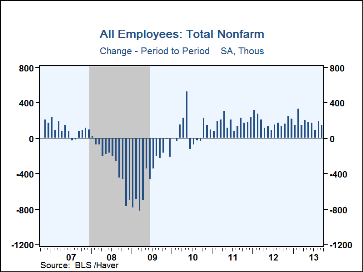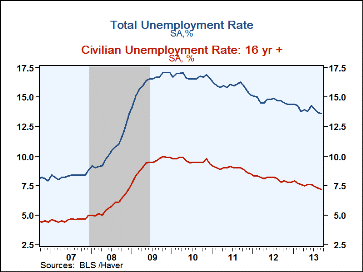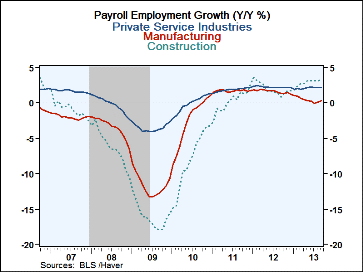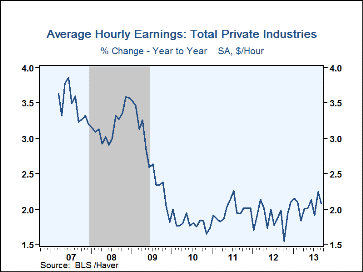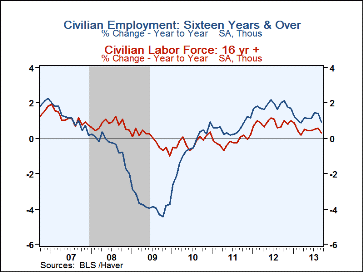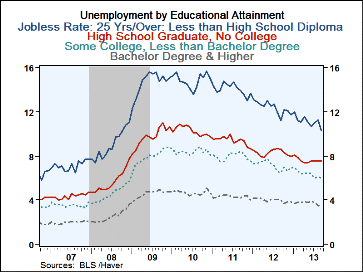 Global| Oct 22 2013
Global| Oct 22 2013U.S. Hiring Continues at a Moderate Rate; Jobless Rate Falls
by:Tom Moeller
|in:Economy in Brief
Summary
In the report on September labor market conditions, delayed by the federal government shutdown, nonfarm payrolls rose 148,000 (1.7% y/y) during September following revised increases of 193,000 and 89,000 in the prior two months, [...]
In the report on September labor market conditions, delayed by the federal government shutdown, nonfarm payrolls rose 148,000 (1.7% y/y) during September following revised increases of 193,000 and 89,000 in the prior two months, earlier reported as 169,000 and 104,000. A 180,000 job increase had been expected in the Action Economics survey. The unemployment rate fell to 7.2%, its lowest level since November 2008. A 7.3% rate had been expected.
From the payroll survey report, employment rose 148,000 (1.7% y/y), weaker than the 185,000 average during the last twelve months. The slowdown was due to a lessened 100,000 gain (2.2% y/y) in private services employment, down from the 169,000 twelve-month average. Growth in retail jobs of 20,800 (2.5% y/y) was slightly weakened as was the 32,000 gain (3.6% y/y) in professional & business services employment. Growth in temporary help services employment, however, remained constant and strong at 20,200 (9.0% y/y). Leisure & hospitality hiring fell 13,000 (+2.6% y/y), off from the 30,000 12-month average. Financial sector jobs also fell 2,000 (+1.2% y/y). A 60,000 worker gain (2.1% y/y) in trade, transportation and utilities picked up some of the slack along with a 22,000 rise (-0.3% y/y) in government payrolls. State government payrolls rose an improved 22,000 but still were down 0.4% y/y. Factory sector jobs rose just 2,000 (0.3% y/y) but construction sector employment improved by 20,000 (3.4% y/y), the strongest gain in seven months.
The length of the average workweek continued to move sideways at 34.5 hours. As a result, the index of aggregate hours worked (employment times hours) rose just 0.1% last month (2.1% y/y). For the quarter, aggregate hours rose 1.2% at an annual rate, the weakest gain since Q2 of last year. During the last five years there has been a 76% correlation between the quarterly gain in hours worked and real GDP growth.
Average hourly earnings ticked up just 0.1% (2.1% y/y). Earnings in the information sector remained firm, however, and posted a 1.0% increase (4.2% y/y). Financial sector earnings ticked up just 0.1%, but rose 3.7% versus last year. Professional and business services earnings were unchanged (1.2% y/y). To the strong side, factory sector earnings gained 0.3% (2.4% y/y) but construction sector earnings slipped 0.1% (+1.4% y/y).
The household sector survey contained a decline in the unemployment rate to 7.2%. That was accompanied by a slip in the total unemployment rate, including marginally attached workers who are involuntarily part-time, to 13.6%. Employment rose 133,000 (0.9% y/y) while the labor force increased just 73,000 (0.3% y/y). The slim rise in the labor force reflected a drop in the labor force participation rate to 63.2%, its lowest since August 1978. Dropouts from the labor force rose 2.1% y/y.
By educational attainment, individuals with no high school diploma realized a 10.3% unemployment rate. Those with high school but no college degree were 7.6% unemployed. Individuals with some college but no degree were unemployed at a rate of 6.0% while those with bachelors degrees or higher were unemployed at a 3.7% rate.
The figures referenced above are available in Haver's USECON database. Additional detail can be found in the LABOR and in the EMPL databases. The expectation figures are from Action Economics and are in the AS1REPNA database.
| Employment: (M/M Chg., 000s) | Sep | Aug | Jul | Y/Y | 2012 | 2011 | 2010 |
|---|---|---|---|---|---|---|---|
| Payroll Employment | 148 | 193 | 89 | 1.7% | 1.7% | 1.2% | -0.7% |
| Previous | -- | 169 | 104 | -- | 1.4 | 1.2 | -0.7 |
| Manufacturing | 2 | 13 | -17 | 0.3 | 1.7 | 1.7 | -2.7 |
| Construction | 20 | 2 | 3 | 3.4 | 2.0 | 0.3 | -8.3 |
| Private Service Producing | 100 | 143 | 112 | 2.2 | 2.2 | 1.9 | -0.1 |
| Government | 22 | 32 | -11 | -0.3 | -0.8 | -1.8 | -0.3 |
| Average Weekly Hours - Private Sector | 34.5 | 34.5 | 34.4 | 34.5 (Sep'12) |
34.4 | 34.4 | 34.1 |
| Average Private Sector Hourly Earnings (%) | 0.1 | 0.3 | -0.0 | 2.1 | 1.9 | 2.0 | 1.8 |
| Unemployment Rate (%) | 7.2 | 7.3 | 7.4 | 7.8 (Sep'12) |
8.1 | 8.9 | 9.6 |
Tom Moeller
AuthorMore in Author Profile »Prior to joining Haver Analytics in 2000, Mr. Moeller worked as the Economist at Chancellor Capital Management from 1985 to 1999. There, he developed comprehensive economic forecasts and interpreted economic data for equity and fixed income portfolio managers. Also at Chancellor, Mr. Moeller worked as an equity analyst and was responsible for researching and rating companies in the economically sensitive automobile and housing industries for investment in Chancellor’s equity portfolio. Prior to joining Chancellor, Mr. Moeller was an Economist at Citibank from 1979 to 1984. He also analyzed pricing behavior in the metals industry for the Council on Wage and Price Stability in Washington, D.C. In 1999, Mr. Moeller received the award for most accurate forecast from the Forecasters' Club of New York. From 1990 to 1992 he was President of the New York Association for Business Economists. Mr. Moeller earned an M.B.A. in Finance from Fordham University, where he graduated in 1987. He holds a Bachelor of Arts in Economics from George Washington University.


